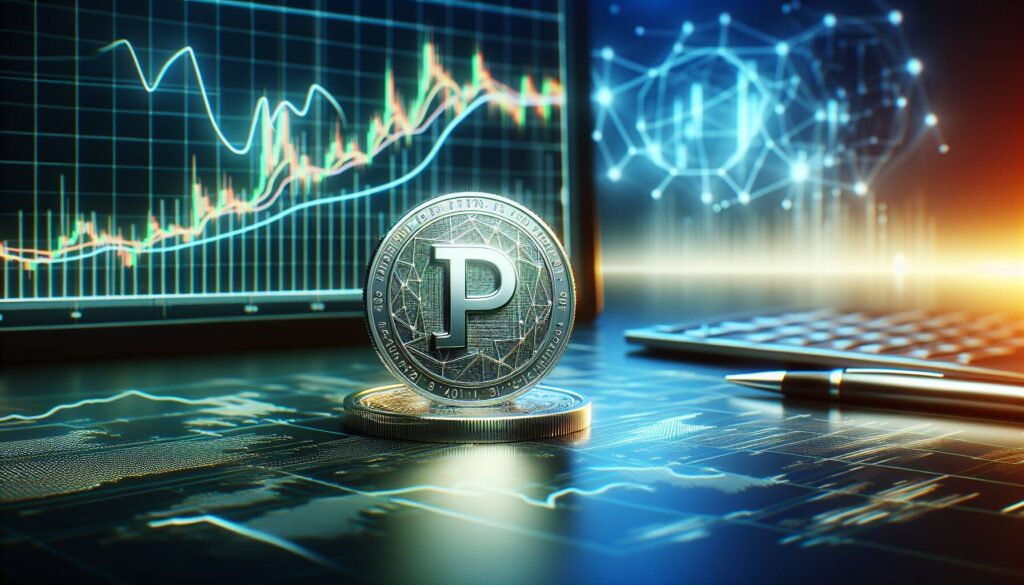In a significant development within the cryptocurrency landscape, the Pi Network has officially launched its native PI token, sending shockwaves through the market. With a self-reported user base of approximately 60 million, this smartphone mining project generated immediate excitement on Thursday, witnessing a rapid price surge. The token debuted at .70 at 09:00 UTC, quickly climbing as high as .00 before experiencing a sharp decline, ultimately settling around [openai_gpt model=”gpt-4o-mini” prompt=”You are a news reporter covering the cryptocurrency industry. Given the article description, provide an introductory overview of the news in an informative style. AVOID using overly technical terms or details! DO NOT offer recomendations to buy or sell any assets! Analyze from a fact-based perspective and bring in additional research when claims are made. Write this overview with creativity and flair, ensuring it reads like a human-written text and incorporates keywords in a natural way for SEO optimization. Generate HTML-formatted content using only
, and
tags. Exclude headings and other HTML tags. DO NOT include a ‘Conclusion’ section! Here is the product description: ‘Pi Network, the smartphone mining project that claims to have 60 million users, released its native PI token Thursday giving traders a roller-coaster ride that saw the price rise 18% in minutes before tumbling 50% over the next two hours.PI debuted at $1.70 at 09:00 UTC, rising to as high as $2.00. It was recently trading at $0.97. The initial surge sent the fully diluted value (FDV) to as high as $195 billion — almost double the value of the Solana blockchain’s SOL.The FDV is based on the maximum supply of a token, 100 billion in this case. The self-reported circulating supply is 6.3 billion, putting its market cap at around $6.1 billion.Pi Network has drawn comparisons to viral projects from previous cycles including SafeMoon, which also attracted a retail audience with aggressive marketing and referral schemes. In order for users to begin mining the Pi token on a mobile device, they must first receive an invitation from another user. They are then issued with an invite code they can share themselves. More tokens are rewarded for each referred user, creating an ecosystem that mirrors multilevel marketing (MLM) or pyramid schemes.The project has been around since 2019 with its testnet going live in 2020. The token release marks start of the Pi Network mainnet, which means that all accrued tokens can be transferred and traded.However, exchanges currently lack sufficient liquidity to handle the billions of tokens being traded. In fact, even the most-liquid exchange, OKX, has a 2% market depth of between $33,000 and $60,000. That means an order of, say, $100,000 would move the price significantly, creating a volatile trading environment.Market depth measures the amount of capital required to move an asset in either direction. Based on the token’s market cap, a 2% move would equate to a $146 million shift in the project’s value.Pi Network has attempted to remedy a disparity between buyers and sellers by offering holders a “lock-up” period, which can be up to three years. If holders opt to lock up their tokens, they will receive higher mining rewards. A similar approach was employed by Richard Heart’s controversial HEX token, which lost more than 99% of its value between 2021 and 2024, rendering many of the locked tokens worthless.'”].97—a staggering 50% drop from its peak.
The buzz around the PI token propelled its fully diluted value (FDV) to around 5 billion, almost twice the value of the well-known Solana blockchain’s SOL. This figure is based on a maximum supply of 100 billion tokens, with an estimated circulating supply of 6.3 billion, giving the project a market cap of approximately .1 billion. Such figures raise eyebrows, drawing comparisons to previous viral projects like SafeMoon, which also captured attention through aggressive marketing and referral initiatives.
Users of the Pi Network must first be invited by current members to begin mining the token, participating in what resembles a multilevel marketing structure. This setup has sparked discussions about the sustainability and long-term viability of such models within the crypto sector. Since its inception in 2019 and the launch of its testnet in 2020, the project has now entered a crucial phase with this mainnet launch, allowing users to transfer and trade their accrued tokens.
“Even the most-liquid exchange, OKX, only shows a market depth of 2% for PI, meaning significant price fluctuations are possible with relatively small trade volumes.”
Interestingly, this low liquidity creates a volatile trading environment, where even substantial orders can lead to drastic changes in price. To counteract some of these challenges, Pi Network is offering a “lock-up” period for token holders, lasting up to three years, in exchange for increased mining rewards. This strategy echoes those seen with other controversial tokens, raising questions about potential risks involved.
Key Points on Pi Network and Its Native PI Token Release
The recent launch of the PI token from Pi Network holds significant implications for its users and the broader cryptocurrency market. Here are the key points to consider:
- Rapid Price Fluctuation:
- PI debuted at .70, experiencing an 18% surge to .00 before plunging by 50% to [openai_gpt model=”gpt-4o-mini” prompt=”Based on the article content, generate a list of key points in an HTML format using Bold, UL/OL. Focus solely on the most important aspects, and describe how they might be related or impact the readers life if at all. Begin with a title using
HTML tag in this format: ‘
Title Goes Here
‘. Use only
,
,
,
- , and
tags. DO NOT include a ‘Conclusion’ section! Here is the topic description: ‘Pi Network, the smartphone mining project that claims to have 60 million users, released its native PI token Thursday giving traders a roller-coaster ride that saw the price rise 18% in minutes before tumbling 50% over the next two hours.PI debuted at $1.70 at 09:00 UTC, rising to as high as $2.00. It was recently trading at $0.97. The initial surge sent the fully diluted value (FDV) to as high as $195 billion — almost double the value of the Solana blockchain’s SOL.The FDV is based on the maximum supply of a token, 100 billion in this case. The self-reported circulating supply is 6.3 billion, putting its market cap at around $6.1 billion.Pi Network has drawn comparisons to viral projects from previous cycles including SafeMoon, which also attracted a retail audience with aggressive marketing and referral schemes. In order for users to begin mining the Pi token on a mobile device, they must first receive an invitation from another user. They are then issued with an invite code they can share themselves. More tokens are rewarded for each referred user, creating an ecosystem that mirrors multilevel marketing (MLM) or pyramid schemes.The project has been around since 2019 with its testnet going live in 2020. The token release marks start of the Pi Network mainnet, which means that all accrued tokens can be transferred and traded.However, exchanges currently lack sufficient liquidity to handle the billions of tokens being traded. In fact, even the most-liquid exchange, OKX, has a 2% market depth of between $33,000 and $60,000. That means an order of, say, $100,000 would move the price significantly, creating a volatile trading environment.Market depth measures the amount of capital required to move an asset in either direction. Based on the token’s market cap, a 2% move would equate to a $146 million shift in the project’s value.Pi Network has attempted to remedy a disparity between buyers and sellers by offering holders a “lock-up” period, which can be up to three years. If holders opt to lock up their tokens, they will receive higher mining rewards. A similar approach was employed by Richard Heart’s controversial HEX token, which lost more than 99% of its value between 2021 and 2024, rendering many of the locked tokens worthless.'”].97.
- This volatility can impact traders’ profits and lead to significant financial loss or gain.
- Market Capitalization:
- The fully diluted value (FDV) peaked at 5 billion, nearly twice that of Solana’s SOL.
- Understanding market cap is crucial for assessing a token’s potential and investment risks.
- Circulating Supply and Market Depth:
- Self-reported circulating supply stands at 6.3 billion tokens, translating to a market cap of around .1 billion.
- Limited market depth at exchanges indicates liquidity issues, leading to extreme price sensitivity to large orders.
- Comparison to Other Projects:
- Risks of Pi Network are reminiscent of past projects like SafeMoon, which used aggressive marketing and referral schemes.
- Users should exercise caution and perform due diligence before investing in similar projects.
- Mining and User Engagement:
- Users can mine PI tokens through invitations, fostering a referral-based ecosystem resembling multilevel marketing.
- This could encourage widespread participation but may also lead to unsustainable growth patterns.
- Lock-Up Period for Holders:
- Pi Network offers lock-up incentives for token holders, reminiscent of strategies used by projects like HEX.
- Such lock-up schemes might enhance rewards but can also trap users in declining asset scenarios.
The volatile nature of PI token trading and its marketing strategies underscore the importance of informed investment decisions in the cryptocurrency landscape.
Comparative Analysis of Pi Network’s Token Launch and Market Performance
The recent launch of the Pi Network’s native PI token marked a significant milestone for the platform, but it also showcased the nature of the volatile cryptocurrency market. With a staggering user base of 60 million, the network has leveraged its community-driven model to gain traction. However, the unpredictable price movements and lack of liquidity bring both advantages and challenges that resemble the trajectories of previous high-profile projects.
In the world of cryptocurrencies, the advent of Pi Network reminds one of the early enthusiasm exhibited by tokens such as SafeMoon. Both projects have effectively attracted retail investors through aggressive marketing tactics and multi-tiered referral schemes. This model can serve as a double-edged sword: while it encourages rapid user growth and initial investment, it also raises red flags regarding sustainability and regulatory scrutiny. The expansion seen in Pi Network can easily attract investors looking to jump on board during its high moments, but it may also lead to skepticism and regulatory challenges as seen in similar MLM-style projects.
The volatile pricing action experienced by the PI token—from an initial high of .00 to almost half that value within hours—could be alarming. In comparison, other tokens with lower volatility and steadier liquidity, like those seen in established cryptocurrencies such as Ethereum or even Solana, present a more stable investment option. The 2% market depth highlighted in the trading volume further reflects the fragility of the trading environment, where substantial orders can dramatically shift the price. This can be appealing for day traders seeking quick profits but poses risks for long-term investors cautious about unforeseen losses.
Moreover, Pi Network’s strategy of offering a lock-up period for token holders may seem beneficial, as it promises higher mining rewards. However, this approach raises questions about the potential for loss of investment value, similar to what occurred with HEX. In a hyper-competitive environment, investors who choose to lock up their funds might find themselves in precarious positions should the token lose value over time, thereby creating anxiety and regret among holders who may have been lured by the promise of substantial returns.
Ultimately, the Pi Network could benefit users with a higher risk tolerance and those attracted to early-stage investment opportunities that thrive on community engagement. Conversely, it may create problems for more conservative investors who prioritize stability, potential regulatory actions against MLM models, and those wary of volatile crypto markets. As the ecosystem evolves, it remains essential for potential users to weigh these advantages and risks carefully before diving into this challenging yet thrilling investment landscape.


















